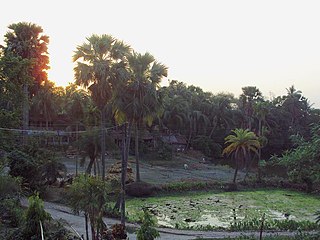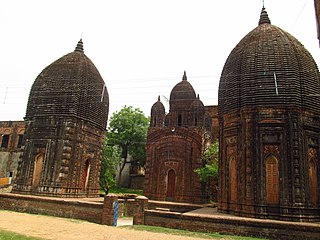
Indian architecture is rooted in the history, culture, and religion of India. Among several architectural styles and traditions, the best-known include the many varieties of Hindu temple architecture and Indo-Islamic architecture, especially Rajput architecture, Mughal architecture, South Indian architecture, and Indo-Saracenic architecture. Early Indian architecture was made from wood, which did not survive due to rotting and instability in the structures. Instead, the earliest existing architecture are made with Indian rock-cut architecture, including many Buddhist, Hindu, and Jain temples.

Marble Palace is a palatial nineteenth-century mansion in North Kolkata. It is located at 46, Muktaram Babu Street, Kolkata 700007. It is one of the best-preserved and most elegant houses of nineteenth-century Calcutta. The mansion is famous for its marble walls, floors, and sculptures, from which it derives its name.

Kalna or Ambika Kalna is a town in the Purba Bardhaman district of West Bengal, India. It is the headquarter of the Kalna subdivision, situated on the western bank of the Bhāgirathi river. The town is more popularly known as Ambika Kalna, named after the goddess Kali, Maa Ambika. It has numerous historical monuments, such as the Rajbari, and 108 Shiva temples. The city of Kalna is 60 kilometres (37 mi) from Bardhaman.

Rupa Goswami was a devotional teacher (guru), poet, and philosopher of the Gaudiya Vaishnava tradition. With his brother Sanatana Goswami, he is considered the most senior of the Six Goswamis of Vrindavan associated with Caitanya Mahaprabhu, a hidden avatar (incarnation) of Krishna in Kali Yuga.

Jiva Goswami was an Indian philosopher and saint from the Gaudiya Vaishnava school of Vedanta tradition, producing a great number of philosophical works on the theology and practice of Bhakti yoga, Vaishnava Vedanta and associated disciplines. He is known as one of the Six Goswamis of Vrindavan and was the nephew of the two leading figures, Rupa Goswami and Sanatana Goswami.

The Architecture of Bengal, which comprises the modern country of Bangladesh and the Indian states of West Bengal, Tripura and Assam's Barak Valley, has a long and rich history, blending indigenous elements from the Indian subcontinent, with influences from different parts of the world. Bengali architecture includes ancient urban architecture, religious architecture, rural vernacular architecture, colonial townhouses and country houses and modern urban styles. The bungalow style is a notable architectural export of Bengal. The corner towers of Bengali religious buildings were replicated in medieval Southeast Asia. Bengali curved roofs, suitable for the very heavy rains, were adopted into a distinct local style of Indo-Islamic architecture, and used decoratively elsewhere in north India in Mughal architecture.

Comilla Jagannath Temple, also known as Sateroratna Mandir or seventeen-jewel temple, is located in Comilla, Bangladesh. It is dedicated to the Hindu God Jagannath.

Samta is a village and a gram panchayat in the Howrah district of West Bengal, India, on the banks of the Rupnarayan river. Samta is noted for being the home of Sarat Chandra Chattopadhyay for twelve years, starting from the year 1923. The terracotta temple of Madangopal jiu is located in the neighbouring village of Mellak. Samta is connected to the state capital, Kolkata, through the National Highway 6, that also connects it to the nearby towns of Bagnan and Kolaghat. Samta hosts few educational facilities including the Samta Sarat Chandra Girls High School, among others.

Baro Shona Masjid, also known as Baroduari Masjid, is located in Gour, West Bengal, India. Completed in 1526, it is situated half a kilometer south of Ramkeli, a village on the way to Gour, and 12 km south of Malda. The mosque with its ruins can be found very close to the India-Bangladesh border. With a gigantic rectangular structure of brick and stone, this mosque is the largest monument in Gour. Even though one of the mosque's names "Baroduari Masjid" implies that it has 12 doors, it actually has eleven in its current state.

The Pancha Ratna Govinda Temple in Puthia village, Rajshahi district in Bangladesh. The temple is a striking monument, which was built in the 19th century. It has the architectural feature of five ratnas or spires. It is located within the inner precincts of the Puthia Rajbari or palace.
Patrasayer is a village in the Patrasayer CD block in the Bishnupur subdivision of the Bankura district in the state of West Bengal, India.

Narajole is a village and gram panchayat in Daspur I CD Block in Ghatal subdivision of Paschim Medinipur district in the state of West Bengal, India.

Mankar is a village in Galsi I CD Block in Bardhaman Sadar North subdivision of Purba Bardhaman district in the state of West Bengal, India.

Sribati or Sreebati is a village and gram panchayat in Katwa II CD block in the Katwa subdivision of Purba Bardhaman district of West Bengal.
Pathra is a village and a gram panchayat in the Midnapore Sadar CD block in the Medinipur Sadar subdivision of the Paschim Medinipur district in the state of West Bengal, India.

Radh Bengal is a region in West Bengal also known as the Temple Town. This region consists of arrays of temples in varying sizes and devoted to different gods and goddess but the common thread unifying this group is that the temples are constructed in terracotta. The region consists of following districts Birbhum, Bankura, Burdwan, Purulia and parts of Murshidabad. The construction style originated in 16th century and lasted till the 19th century. This period is also referred as a golden age of temple in West Bengal. Reason for development of this construction technique was the rich red laterite soil of the region and lack of construction worthy stone. The skill of creating daily objects from like vessels, pottery, seal and toys evolved into a construction technique in the time of need. These temples are baked terracotta panels or bricks. This particular style spread outside the present day West Bengal as well, to Jharkhand, Bihar, Assam and Tripura.
Ramkeli Mela is a pilgrimage and fair of Hinduism. On the occasion of this fair, devout Hindus come to Ramkeli. Generally the Ramkeli fair is organized every year at Ramkeli. Ramkeli is known as the Gupto Vrindavan, an important pilgrimage site for the Vaishnavism.

Kotulpur Sridhar Temple is a Vishnu temple at Shiromanipur village in West Bengal. Hindu God Vishnu is worshiped as Sridhar (Shaligram) in this temple. It is located in Kotulpur police station of Bankura district. Built by Bhadra family known as traders and zamindars, the temple stands within the Bhadra palace. The temple is a great example of ratna architecture, which was erected in the early-fourth decade of the 19th century.

Radha Shyam Temple or Rādhāśyāma mandir is a Krishna temple in Bishnupur town of Medinipur division in Indian state of West Bengal. In this temple, the Hindu god Krishna is worshiped in the form of Shyam; along with Shyam, the murti of Radha is also worshipped. According to the foundation plaque found in the temple, the temple was founded in 1758 by King Chaitanya Singh of Mallabhum. The temple is a unique example of eka-ratna temple architecture, which belongs to the ratna style developed in medieval Bengal.



















